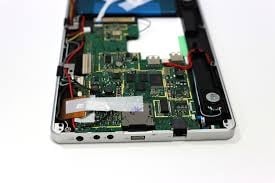Share this
How Are Industrial Kilns Used In Smartphone Manufacturing?
by Therser Sales Team on 08-Feb-2019 11:01:00

The hellish conditions of an industrial kiln may at first seem the least likely environment for manufacturing something as intricate and delicate as a smartphone. However, the average smartphone contains around 200 individual ceramic parts, all of which require firing in an industrial furnace. Transition-metal oxide based ceramics fulfil an important role in smartphones and can be found in a number of components. It’s true to say that contemporary smartphones would be radically different without ceramic parts!
Properties of Ceramic Parts
The most fundamental attribute of ceramics is their semi-conductivity, the cornerstone of modern technology. They are, furthermore, superconductors, magnetic, dielectric, pyroelectric, insulators and have piezoelectricity properties.
Consumer demand for smaller electronic devices and the ability to miniaturise ceramic components has increased the importance of ceramics in smartphone technology. The ecological impact of ceramics is modest when compared to materials with similar properties, like tantalum.
These properties result in the presence of ceramics almost everywhere in smartphones through electronic components with single and multiple functions.
Here are some examples:
Capacitors
This device stores and delivers an electrical charge and is one of the most basic yet important parts of a smartphone. The number of capacitors in phones is increasing. Apple’s latest model is said to show an increase of 10% with over 1,000 capacitors. The development of ceramic capacitors resulted in a drastic reduction in size of the typical processor. Sub-micron sized particles are used in modern capacitors to improve charge retention. Innovative techniques allow the creation of dielectric layers thinner than one-tenth of a micrometre, so capacitors are small enough to fit in mobile phones but can handle complex tasks.
Smartphone Antennae
In most phones the antenna is ceramic. This component is vital for voice transmission and reception. Ceramic properties make it ideal for not only smartphone antennae but also the antennae in GPS and Bluetooth systems.
Dielectric Resonators
These electromagnetic components are integral in GPS and a variety of wireless technology. Ceramic dielectric resonators are used because they have a high relative permittivity and near zero temperature coefficient.
Insulation
Metal film resistors are placed on a ceramic base making use of the ceramic’s hard insulating properties. Other examples are in the outer covering of sensitive integrated circuit chips and the creation of heat sinks to maintain safe temperature levels in the processor. Ceramic’s hardness, stability and low cost make it ideal.
System on a Chip (SoC)
A SoC is found in all phones and contains the graphics processor, the microcontroller and the RAM. There are potentially millions of components within these components, and it would be impossible without the use of ceramics.
Battery Life
Ceramic components within the battery are crucial in energy management and conservation of energy within smart grid products. This reduces energy cost and increases the performance of the mobile device.
Timers
An example of the piezoelectricity property of ceramics is in the use of timers. An electric field will oscillate at a fixed frequency when applied across certain ceramics. This is utilised when inserting timing properties in smartphone computer systems.
Ceramics permeate all phones and are a vital aspect throughout the technology. Without ceramics we simply would not have the modern smartphone as we know it.
At Therser UK we are proud to serve clients in a diverse range of sectors across the world. To find out more about our kilns, furnaces, dryers, RTOs and engineering services, download the free guide or email sales@therseruk.com or call 01782 824453 to speak with a sales advisor directly

Share this
- Company News (90)
- Battery Materials (41)
- kiln (37)
- fabrication (29)
- Alloy (27)
- Furnace (27)
- Welding (16)
- Industrial Kilns (15)
- Battery (13)
- Ceramic Kilns (13)
- Processes (13)
- alloy fabrication (13)
- Shuttle Kilns (12)
- RTO’s (11)
- Vacancies (11)
- Hydrogen (10)
- Therser UK (9)
- Tunnel Kiln (9)
- Refractory (8)
- Therser (8)
- Wellman Furnaces (8)
- Brickwork (7)
- Case Studies (7)
- Afterburners (6)
- Fibre Lining (6)
- electric (6)
- Almor Wellman (5)
- thermal engineers (5)
- Biochar (4)
- Exhibition (4)
- Pyrolysis (4)
- Servicing (4)
- Spares (4)
- heat treatment (4)
- History (3)
- Ceramics Uk (2)
- Combustion Control Upgrades (2)
- Nitrogen (2)
- Temperature Control Rings (2)
- gas (2)
- Certificates (1)
- Instrumentation (1)
- MMC (1)
- RHK (1)
- Roller Hearth Kiln (1)
- Test Trials (1)
- aerospace (1)
- analyser (1)
- elec (1)
- oxygen (1)
- vans (1)
- September 2025 (2)
- May 2025 (2)
- March 2025 (1)
- February 2025 (2)
- January 2025 (5)
- December 2024 (5)
- November 2024 (7)
- October 2024 (5)
- September 2024 (4)
- August 2024 (14)
- July 2024 (13)
- June 2024 (2)
- May 2024 (5)
- April 2024 (13)
- March 2024 (8)
- February 2024 (12)
- January 2024 (14)
- December 2023 (6)
- November 2023 (12)
- October 2023 (24)
- September 2023 (11)
- August 2023 (11)
- July 2023 (9)
- June 2023 (15)
- May 2023 (53)
- April 2023 (5)
- March 2023 (6)
- February 2023 (7)
- January 2023 (3)
- December 2022 (8)
- November 2022 (5)
- October 2022 (11)
- September 2022 (1)
- August 2022 (2)
- July 2022 (1)
- June 2022 (2)
- May 2022 (1)
- March 2022 (1)
- February 2022 (1)
- January 2022 (1)
- December 2021 (3)
- October 2021 (1)
- August 2021 (1)
- June 2021 (1)
- May 2021 (4)
- April 2021 (2)
- March 2021 (4)
- February 2021 (2)
- December 2020 (3)
- November 2020 (1)
- September 2020 (3)
- May 2020 (1)
- April 2020 (2)
- March 2020 (1)
- January 2020 (1)
- December 2019 (1)
- July 2019 (2)
- June 2019 (1)
- April 2019 (2)
- March 2019 (3)
- February 2019 (4)
- December 2018 (1)
- November 2018 (1)
- September 2018 (2)
- August 2018 (1)
- July 2018 (1)
- May 2018 (3)
- April 2018 (1)
- February 2018 (3)
- January 2018 (2)
- December 2017 (3)
- November 2017 (1)
- October 2017 (2)
- September 2017 (4)
- August 2017 (1)
- July 2017 (2)
- June 2017 (2)
- May 2017 (3)
- April 2017 (3)

